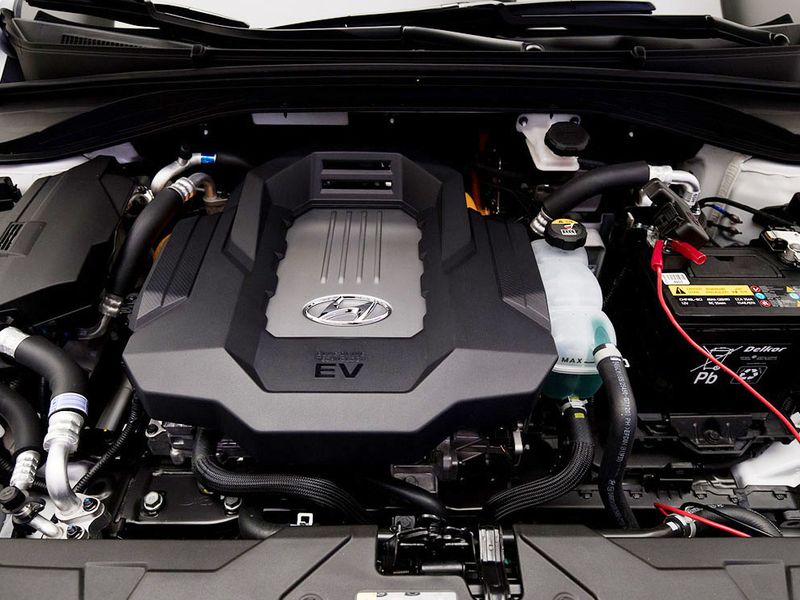
Hyundai Motor Group intends to carve out a share of the electric vehicle market starting next year with the first two battery-powered crossovers from its new e-GMP platform.
The flexible platform is key to the South Korean automaker’s target of selling 1 million EVs globally by 2025.
Last week in Seoul, the company unveiled the e-GMP architecture, short for electric global modular platform, with executives promising sporty performance.
The base layout will be rear-wheel drive, with a low center of gravity, long wheelbase and short overhangs. The setup is geared toward larger vehicles from the C-segment and above, all the way to a seven-seat crossover in the realm of the Hyundai Palisade, the automaker said. And it can accommodate a wide range of vehicle body types, from sedans and crossovers to performance cars.
All three of the auto group’s brands — Hyundai, Kia and Genesis — will use e-GMP, and the marques will differentiate their offerings mainly through design and onboard amenities.
The automaker is focusing on 23 all-electric models to meet that 1 million-vehicle target, including e-GMP models and electric derivatives of vehicles that are also offered with internal combustion engines.
The common platform will be Hyundai’s strategy in a hot industrywide EV race that includes such global behemoths as General Motors and Volkswagen. VW said last month it will spend about $88.6 billion on future technologies, partly to produce about 26 million EVs in Europe, China and the U.S. by 2030. GM, meanwhile, wants to make 40 percent of its U.S. lineup electric by 2025.
Of the Hyundai group’s 23 planned electrics, 12 will be derivatives and 11 dedicated. Hyundai won’t say how many of the 11 will ride on e-GMP, but the first e-GMP nameplate will be the Ioniq 5, a midsize crossover debuting in 2021. That will be followed later next year by an e-GMP crossover from Kia.
Driving dynamics will help set the South Korean EVs apart from other pluggable cars being rolled out by rivals around the world, said Albert Biermann, Hyundai Motor Group’s global R&D head.
For starters, the rear-wheel layout with the main motor on the rear axle will deliver “a lot of fun,” he said. But the vehicles can also be reconfigured as all-wheel-drive by adding a front motor.
E-GMP, which features an all-new battery and motor, can cover 0 to 62 mph in less than 3.5 seconds, with a top speed of 161 mph, Hyundai said. The new vehicles can drive up to 310 miles on a full battery, which can recharge to 80 percent in 18 minutes. But Hyundai’s figures were drawn from the European testing cycle — the Worldwide Harmonized Light Vehicles Test Procedure, considered more generous than what will eventually be U.S. EPA-certified numbers.
Next year’s Kia model will be a “very powerful version,” Biermann said. And a high-performance EV concept is expected to be shown also in 2021. “We are working on this for quite some time and preparing for a very emotional battery-electric driving experience,” Biermann said.
Depending on the configuration, the e-GMP system can churn out up to 600 hp, he said.
Driving dynamics will be enhanced by a five-link rear suspension and what Hyundai calls the world’s first mass-produced integrated drive axle. That technology combines wheel bearings into the driveshaft for better comfort and stability.
Energy density in the new battery has been increased 10 percent to deliver better punch from lighter packaging. A new cooling block structure also makes the battery pack more compact.
The new motor, which receives such tweaks as oil cooling and a new “hairpin” winding method for its coil, delivers a 70 percent increase in its maximum rotation speed to over 20,000 rpm.
The motor is controlled by an inverter using silicon carbide semiconductors that expend less energy. That in itself adds about 5 percent to the vehicle’s overall driving range, Hyundai said. But the keyword of the new architecture is flexibility. Aside from crossovers and performance cars, e-GMP will underpin fleet vehicles, including a future robotaxi, Biermann said.
“E-GMP is a wonderful starting point to make very beautiful designs,” he said.
“It offers a wide scope of opportunities for all kinds of user and driving experiences for all of our three brands.”